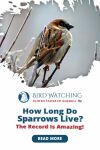
What’s This Post About?
Sparrows are known to be extremely competitive in terms of their nesting and feed. They don’t shy away from hoarding another bird’s feeder or in some cases even occupying their nesting site.
The sole reason for this is because they are not very picky and will eat most things and reside anywhere they find a cavity or opening.
Sparrows on an average live for 3 years. House sparrows are generally short-lived and have an average life span of 3 to 5 years. Multiple factors like predators, environment, and diseases affect their lifespan.

What Is the Lifespan of Sparrows?
A wild sparrow generally lives up to the age of three years. They may also live for a longer time as indicated by the record of the longest surviving sparrow. However, their average lifetime in the wild is significantly less.
Did You Know?
Sparrows can survive longer in captivity. They have an average lifespan of 12 to 14 years in confinement.
Sparrow eggs take 11 days to hatch. When the fledgling birds are just 14 days old, they leave the nest and spend another day or two on the grounds after leaving the nest.
7-10 days after leaving the nest, the young are self-sufficient. After they leave the nest, they become susceptible to various things that contribute to their individual lifespan.

The Lifespan of Various Sparrows
It’s easy to locate sparrows in North America. They can be found in nearly every area. They can be found in huge numbers, singing sweetly (for the most part), and consistently brightening up your feeders.
An average house sparrow’s life span is 3 years. There are however other fascinating sparrows found in North America that tend to live longer. The reason for their short life depends upon their region and the problems they are exposed to.
| Sparrow | Lifespan | Leading causes of death | Region |
|---|---|---|---|
| Song Sparrow | 3-5 years | Collisions (particularly with glass), outdoor cats, and pesticides | North America |
| Saltmarsh Sparrow | 9 years | Climate change and associated sea-level rise, Habitat loss | North America |
| Black-throated Sparrow | 5 years | Pesticide use, habitat loss, cat predation | American Southwest |
| Vesper Sparrow | 6 years | Pesticide use, habitat loss | North-central United States |
| Grasshopper Sparrow | 7.1 years | Loss of wintering habitat, use of pesticides, brood parasitism by Brown-headed Cowbirds | Florida |
| Dark-eyed Junco | 3 – 11 years | Habitat loss, window collisions. | North America |
| White-throated Sparrow | 9 years | Window collisions and attacks by cats. | Eastern and southern North America |
The Amazing Record

It’s difficult to find precise data on the lifespan of birds since it’s typically hard to track large flocks of birds from birth till death.
It is slightly easier to keep track of a bird if it has been captivated. The longest sparrow in captivity was recorded to live up to 23 years.
The difference between the record and an average lifespan is so great, that any justification does not explain it.
The oldest sparrow was able to live 20 years longer than an average sparrow. This however was in captivity. The oldest wild House Sparrow recorded is 13 years.
Factors That Affect the Lifespan of a Sparrow
Predators, injuries, parasites, and viral illnesses claim the lives of about half of young birds before they even turn one.
The length of time of a sparrow’s life is primarily determined by its species. However, aside from natural phenomena, there are a few more variables that influence how long a sparrow can live.
Sparrows can live for up to seven years if they can avoid the effects of these conditions.
Predators
House sparrows are invasive and disruptive birds.
Their aggression toward other birds, an inclination for forming guarded groups, capacity to breed quickly, develop quickly, consume a broad variety of foods, and nest close to people have allowed them to disseminate throughout the globe.
House sparrows have few predators, probably due to their propensity for nesting mostly around human-populated areas. However, this does not make the bird immune to any sort of predation. They may be intimidating themselves, but they are also hunted by other species.
House sparrow eggs, nestlings, and potentially even adults may be eaten by crows, grackles, jays, and other small hawk species.
Gray and red squirrels are also known to attack nests. Domestic cats, on the other hand, are the main predators of adult house sparrows.

A sparrow, on the other hand, will be able to live happily and likely to live its entire life in sync with its bodily system if there are no predators.
Diseases
An outbreak will drastically reduce the number of sparrows and drastically shorten their lives. Sparrows travel in flocks and colonies. It will be quite easy for an epidemic to spread among them.
Winters can get very cold, while summers can get blistering hot, causing many birds to fall victim to diseases and parasites. Several diseases affect House Sparrows in homes, some of which are curable.
For example, chicken mites are very common amongst sparrows, pigeons, and starlings. They feed on the birds’ blood. This is almost unavoidable. Sparrows can get chicken mites no matter how cautious you are or how sanitary you keep things.

External pests have a great impact on your bird’s health, and extreme illnesses can put them on the verge of death.
A sparrow’s lifetime is also shortened by injuries that result in fatality. Fatal injuries that induce a shift in a sparrow’s activity have an effect on how long it lives.
Environment
House sparrows are very adaptive, but that doesn't imply they can flourish in every change to their environment that people make.
The environment also has a significant role in deciding how long a sparrow may survive.
This factor however isn’t the most contributing factor since the house sparrows are opportunists and will essentially feed on everything. They do not depend on the people to specially put out feed for them.
A sparrow that lives in an environment where it can receive enough food and reproduce effectively will survive for many years. Sparrows will be able to grow and survive in areas where there are sufficient resources for their existence.
However some recent developments may also hamper their lifespan.
-
Livestock is increasingly being reared in enclosed spaces, sometimes even inside. As a result, there are fewer opportunities to eat grain.
-
Similarly, municipal sanitation has improved, making it more difficult for sparrows to locate feed.
-
The worldwide insect decrease might possibly have a role.

Did You Know?
A sparrow’s diet consists of 60% livestock feed.
Humans
Dangerous substances used in farming hurt far more than the animals they're supposed to help, and they do so in the most subtle ways.
Imidacloprid, a common pesticide, causes sparrows to lose a lot of weight and postpone their migration, thus depriving the birds of their best opportunity for a normal mating season.
Timing is essential for a fast-moving bird; its prospects of securing a decent nesting location, connecting with a suitable partner and having healthy young increase if it arrives early in the spring mating season.
Did You Know?
The bird population that have been declining globally for decades can be blamed upon most widely used insecticides.
Another way humans contribute to the early deaths of sparrows is via the process of nest removal.
Sparrows end up building nests in any and every hole they find around the house. They may even block your vents. Some people attempt to remove the nest while it is inhabited by the bird.
The young need to be attended by its parents for at least two weeks. Constant visitation by people to their nests may result in the parents abandoning the nests. Without the parents, the survival of the young is close to impossible.

Sparrows Themselves
You may be surprised to know that there aren’t always external factors that result in the death of a sparrow. There are multiple cases where a sparrow itself might be the cause of another fellow bird’s death!
If one of the chicks becomes infected or unwell or is malformed in any way, the mother sparrow will either kill it and consume the remnants for food, or move it out of the nest to protect the remaining kids.
Sparrows aren’t the smartest birds especially if they are first-time mothers. They get fearful and confused regarding the steps they should take.
Further, sparrow is constantly attempting to assert authority over other flock members. The House Sparrow is a very aggressive bird. What’s shocking is that they will compete and fight with other sparrows also.
When vying for nesting locations, they will intimidate, attack, and kill less dominant sparrows, as well as damage their eggs and young.
Your Role in Reducing This Risk
While sparrows may not always be house-friendly, you must still ensure that the bird is not dying on your watch.
Predators
Keep your pets under control and take precautions to safeguard the sparrows in your backyard from cats. Here are some other things you could do as well.
-
Provide secure birdhouses for breeding birds that are out of the reach of any potential predator.
-
Pet cats should be kept indoors at all times. If they must go outside, make sure they are monitored.
-
Attach a bell to your domestic cats to alert the birds when it approaches.
-
Keep the nails of the pets trimmed to deter them from climbing the trees.
Warning
Do not encourage the cat even if you consider the sparrow an invasive bird. This can happen unintentionally if you for example put out feed right after it has captured the bird.
Diseases and Infections
Even though this does not guarantee parasite prevention, doesn’t mean you pay any less attention to it. Always remember to clean birdhouses especially before and after breeding seasons.
Cleaning the feeders and nesting houses will decrease the chances of the disease being spread amongst other sparrows. Always stay alert and inform a professional in the case of any such sign that indicates potential illness.
Human
House sparrows can turn out to be quite the nuisance. If a bird has set up a nest in a hazardous place on your premises, is causing harm to your house, or is blocking the area from being used, it’s preferred that you call for help.
If you can wait and the space they have occupied does not need immediate vacating, let the nesting period get over. Once the nest is not occupied, you can proceed to dismantle or relocate it.
Warning
Do not attempt to relocate the nest if the eggs are still in it.
Can Sparrows Survive in Captivity?
Confining sparrows may be the only option for averting extinction, according to many experts.
Sparrows kept in captivity are significantly safer than wild birds. There is no need for captive sparrows to be concerned about predators preying on them. However, when compared to the risks and stress of survival encountered by other wild birds, they are little.

In fact, many biologists consider captivity as the sole alternative for avoiding possible extinction.
If the sparrows are allowed to live in the wild without intervention, they might likely go extinct. The reason for this is habitat loss, storms, predators, and even fire ants.
Did You Know?
About one-fifth of the songbirds fall victim to fire ants before they even depart their nest
While captivity may be considered safer in comparison, it is not short of problems.
The most common is the prevalence of parasites despite keeping all cleanliness precautions in check. The other issue is that keeping the birds captive might decrease their natural survival instincts and habits.
To ensure that you do not deprive an entire species of their natural lifestyle in the hopes of keeping them alive, be sure to leave some birds out in the wild. These birds can then act as a guide for the birds that are released from captivity later.
Pro-Tip
Do not keep sparrows captive for longer than necessary. They belong in the wild and they have a role to play to balance the ecosystem.
Keep Reading!
Even though the number of House Sparrows has been declining over the years due to various factors, it continues to be one of the most widespread birds in America. The average life span is 3 years while the record goes as high as 23 years of survival.
Due to various factors like predators, collisions, and pesticides, sparrows may live a shorter life. However, there are significant chances of a sparrow living longer if kept in captivity since they would then be safe from predators for instance.
If you wish to read up on other birds, here’s a post you must read through to find out which predators do hummingbirds have.

By David A. Swanson
Bird Watching USA
My name is David and I'm the the founder of Bird Watching USA! I started Bird Watching with My father-in-law many years ago, and I've become an addict to watching these beautiful creatures. I've learnt so much over about bird watching over the years that I want to share with the world everything I know about them!

David A. Swanson
Bird Watching USA
My name is David and I'm the the founder of Bird Watching USA! I started Bird Watching with My father-in-law many years ago, and I've become an addict to watching these beautiful creatures. I've learnt so much over about bird watching over the years that I want to share with the world everything I know about them!








